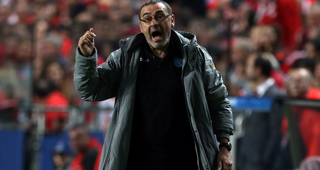Maybe it’s this bout of possession involving 33 consecutive passes. Or this incisive counter attack resulting in the match winning goal against Milan. Or an intricate sequence against SPAL showcasing the side’s quick passing and movement through the middle. Whether long passing sequences or transitions hit at pace, Maurizio Sarri’s Napoli sides scored enough variety of goals to satisfy any supporter. And after a prolonged negotiation period involving battles of financial and player compensation, the 59-year-old Sarri finally brings his entertaining style to Chelsea.
The foundation of Sarri’s possession-based 4-3-3 shape begins with provoking defenses out of position through short passes and exploiting the space left behind. His orchestrator at the base of midfield is the 26-year-old Jorginho, whom Sarri snatched at last minute from Manchester City and brought to Chelsea order to replicate their passing movement. Jorginho averaged 97 passes with a 90% passing completion percentage last season at Napoli and will be relied upon to set the tempo for Chelsea’s attack (he’s already coaching N’Golo Kante). Sarri continued to put his mark on the club by replacing Thibaut Courtois with 23-year-old keeper Kepa Arrizabalaga for a position record $90 million. Similar to Liverpool’s previous record signing of Alisson, the transfer fee reflects how essential goalkeepers have become in the build-up phase.
But it may be another unlikely midfielder who becomes the symbol of Sarri’s time at Chelsea. 24-year-old Ross Barkley finished his first full match in his short Chelsea career last week in the Community Shield match. Sarri can choose from more technical midfielders like Cesc Fabregas, but in valuing Barkley’s aggressiveness and pressing intensity, the Italian manager is showing how he must adapt to the demands of the English game. While Sarri insisted that Barkley improve the defensive side of his game in order to play alongside Jorginho and Cesc, he does offer a forward dynamism unique amongst Chelsea midfielders. For his part, Barkley asked Chelsea supporters for patience as Sarri implements a new approach.
Barkley’s reinvention showcases the savvy Sarri needs to discover in his leftover roster remaining from the Antonio Conte era. Conte’s 3-4-3 formation suited the strengths of his players who made not fit a traditional setup. The shape allowed David Luiz to focus more on controlling play than defending, and lack of positional discipline on the defensive side is prone to get exposed in a back four. Marcos Alonso and Davide Zappacosta were brought on as wingbacks, a role that doesn’t exist in Sarri’s formation. Danny Drinkwater won the league as part of a midfield two alongside Kante, but he too is caught between Jorginho’s playmaking, Kante’s box-to-box ability, and Barkley’s athleticism.
Thierry Henry once asked Conte to describe the biggest difference between Serie A and the Premier League, to which Conte responded with how each league controls a match. When you’re up 1-0 in Italy, you can “manage the situation”, according to the former Chelsea manager. But a culture of long balls creates havoc and unforeseen chances until the final whistle, leading to exciting, unpredictable matches that must be played until the end. Before he was hired at Manchester City, Xabi Alonso implored Pep Guardiola to work on winning the second ball outside of their own penalty area. Guardiola noted how often the defender and the striker are on opposite ends of the field, only connected by the long ball and the subsequent second ball.
Sarri said that Guardiola warned him about the difficulty of adapting to the Premier League, especially in his first season. Guardiola also described his Napoli side from last season as the best team he’s ever played, and that the Italian manager will further raise the English standard with his passing ideas. We know how a successful Chelsea side under Sarri would play like - a side passing and moving with pace, quick interplays, and individual brilliance. We can also predict how Sarri would fail, unable to adapt to the physicality and unpredictability of the league. He’s given himself three months of space to adapt, but that timeline seems optimistic. His basic principles are in place. But Chelsea’s season lies upon how much their 59-year-old manager is willing to struggle, learn and ultimately adapt without sacrificing his style.



